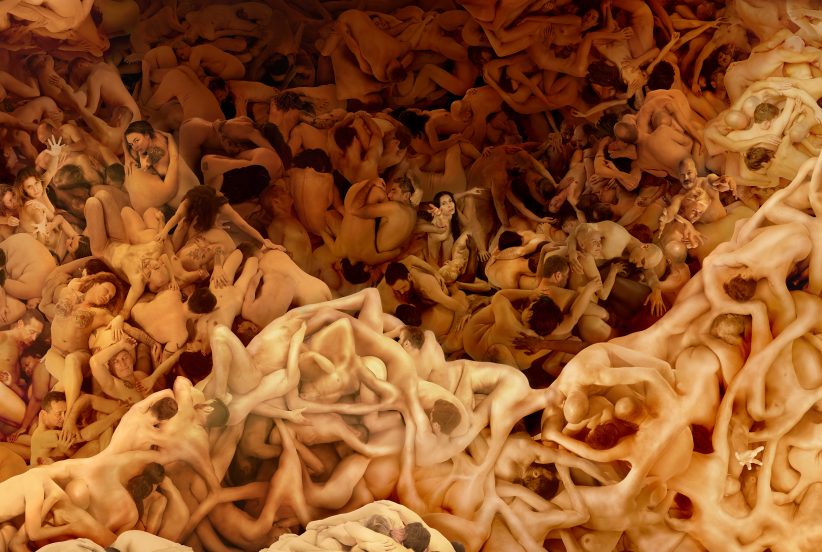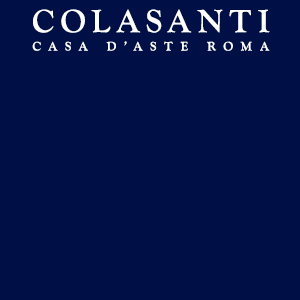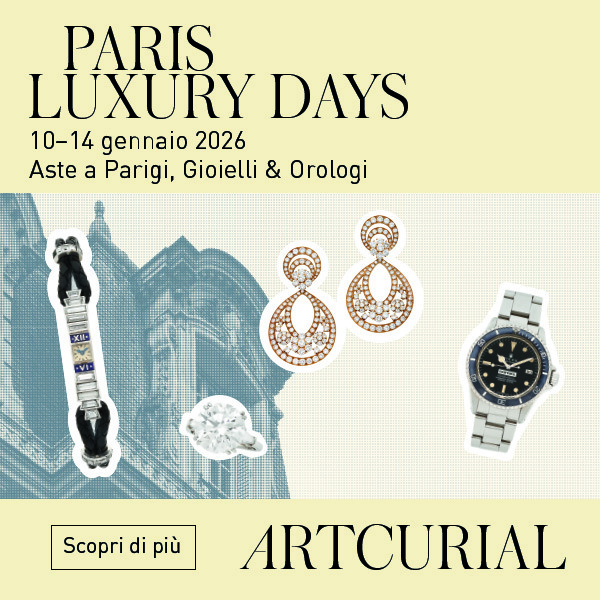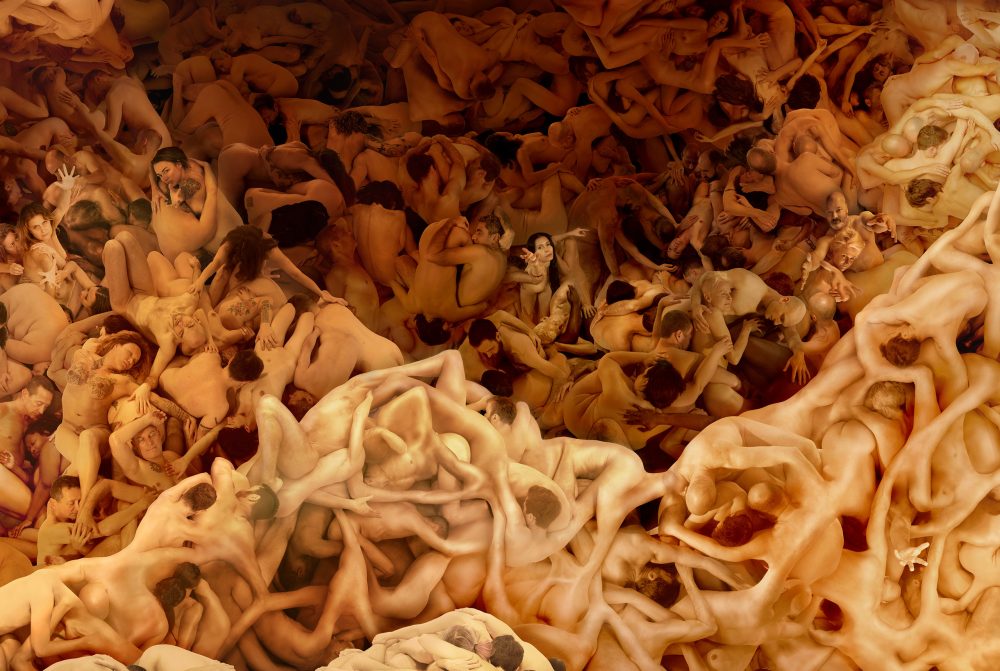
Da anni crea affascinanti foto e video mettendo al centro il corpo umano nudo. Ora il percorso di Angelo Musco diventa un film
“Tra corpo e anima vige un rapporto materia-forma, come se l’anima fosse la vera forma del corpo”. Il pensiero di Aristotele rispecchia quello che era il ruolo del corpo umano nell’arte classica. Lo scultore si concentrava sulle sembianze umane cercando di restituirne realisticamente le forme. Esaltandole, nel caso di eroi, di sovrani, di atleti. Assegnando valenza espressiva alle dinamiche spaziali, ai gesti, agli sguardi. Si pensi, solo ad esempio, ai Bronzi di Riace, al Discobolo di Mirone, al Laocoonte.
Nei secoli successivi questo approccio è stato spesso replicato. Basta pensare a Michelangelo nella scultura, o a Mattia Preti nella pittura, sempre per esemplificare. Il corpo umano è tornato centrale nei suoi caratteri formali massimamente con il Barocco – opere come il Ratto di Proserpina di Gian Lorenzo Bernini ne sono paradigma – e con il Neoclassicismo (Le tre grazie di Antonio Canova). Tuttavia certe dinamiche socio-culturali andavano via via introducendo elementi nuovi: come il Concilio di Trento, che legò strettamente la rappresentazione della figura umana alle finalità devozionali.
Il corpo come “medium”
Con il passare dei secoli, pur con le dovute eccezioni, il corpo umano cessò di esistere nelle arti per i suoi valori formali. Divenendo progressivamente strumento funzionale a comunicare messaggi, ad esprimere sensazioni ambientali o sociali. Detto del cattolicesimo, contribuì a questo anche il puritanesimo protestante: esiste un dipingo fiammingo con un corpo nudo? E così via, fino al Realismo ottocentesco, alla Nuova oggettività novecentesca. E anche alla Pop Art, che trasforma il corpo in oggetto.
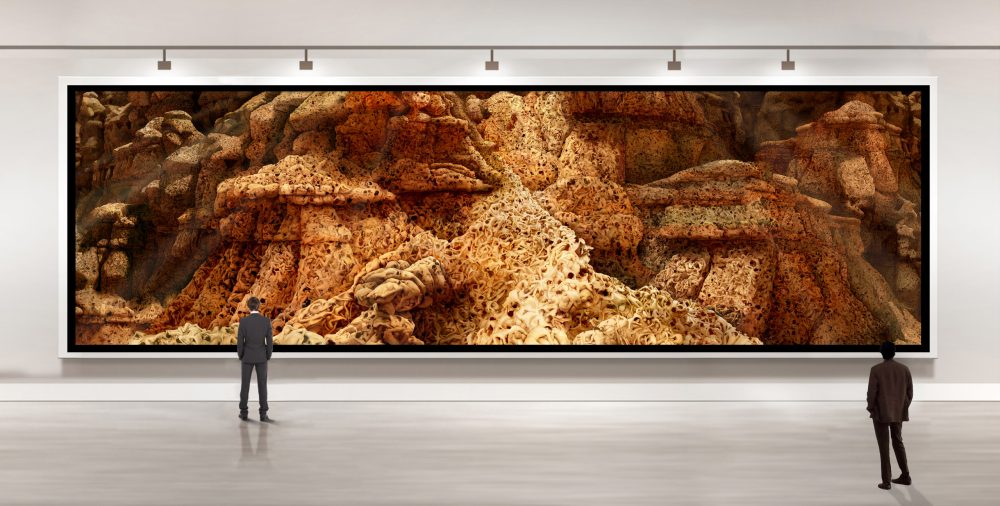
Nell’arte contemporanea ricompare il corpo scevro dai cascami sociologici: per tutti basti citare Robert Mapplethorpe, con le sue statue fotografiche scolpite dalla luce. Ma c’è un artista italiano che da decenni pone le forme del corpo umano nudo al centro della propria ricerca. Non come “soggetto” delle sue fotografie, o dei suoi video, ma come “medium” nella costruzione di affascinanti e monumentali textures. Una “palette” di forme organiche che – rielaborate in studio – vanno a costruire altre forme. Architetture fantastiche, nidi, fiori, piume, banchi di pesci.
Dimensioni monumentali
Parliamo di Angelo Musco, origini napoletane ma formatosi e ormai stabilmente residente negli USA, fra New York e la Pennsylvania. Da dove ha raggiunto un successo internazionale, con mostre e presenze a rassegna di assoluto prestigio. Grazie anche a un rigoroso metodo di lavoro, sempre di apertura globale. Centrale è la selezione dei soggetti che poi andranno ad animare le sue composizioni, coinvolgenti, spesso sensuali, a volte quasi inquietanti. Quando vanno ad evocare turbinii che richiamano gironi danteschi, o Giudizi Universali, probabilmente ammirati nei suoi anni italiani. “Nasco pittore nella Napoli barocca, quella sotterranea, quella delle vite sospese, e quella delle mitologie greche”, puntualizza.
Una prassi creativa decisamente laboriosa: fra calls lanciate per i casting, scelta delle location, shooting fotografici. Sessioni fissate in tutto il mondo, da New York a Berlino, Londra, Parigi, Buenos Aires, presto in Nuova Zelanda e Australia, fino alla natia Napoli, con migliaia di volontari coinvolti. E seguite da un lungo lavoro di post produzione. L’ultima impresa di Musco è un nuovo progetto fotografico, avviato da oltre 4 anni. Si tratta di “The Land of Scars” (La terra delle ferite), opera dalle dimensioni monumentali, circa 12 metri per 3 e mezzo. “Un progetto in cui i soggetti che appaiono sono tutte le persone che hanno lasciato un segno nella mia anima, e che hanno modificato la mia vita e quotidianità negli ultimi venti anni”, racconta l’artista.
Autobiografia scritta da storie e persone
“Un immenso diario emotivo”, lo definisce. Che ha deciso di raccontare con un film che ne ripercorre la complessa evoluzione. E che diventa quindi una sorta di autobiografia scritta da storie e persone. “The Land of Scars” – titolo omonimo – ha avuto già una première a New York, nel teatro della School of Visual Arts. In attesa del lancio pubblico, in questi giorni viene rilasciato il trailer definitivo. Noi abbiamo chiesto ad Angelo Musco di parlarcene…
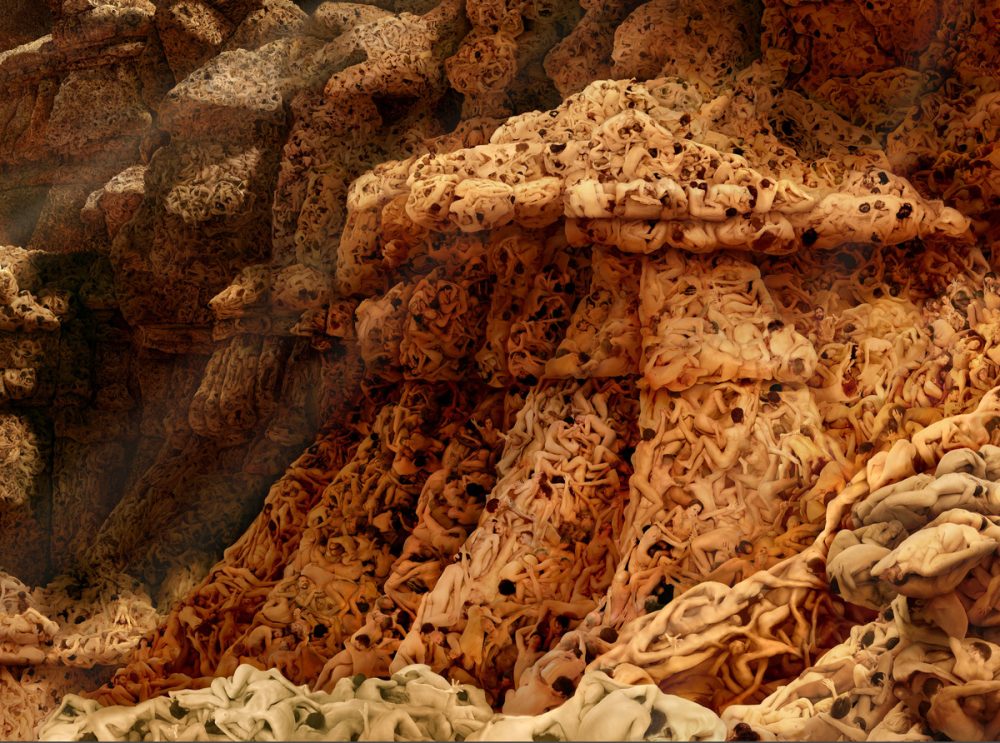
Sei noto per l’utilizzo del corpo umano, ma il film si apre con affascinanti immagini di paesaggio. Il tuo sentimento panico guarda anche alla terra?
La terra, il suo odore, calore e materia sono al centro di questo diario visivo, quindi assolutamente si. Una connessione più visibile che mai, questa volta non è solo visiva, ma fisica, in diretto contatto col mio corpo, quest’ultimo presente per la prima volta nel lavoro in maniera radicale. Una ricerca introspettiva di radici interiori, e per farlo succedere ho dovuto iniziare un lunga ricerca dentro ma anche fuori di me, cambiando i luoghi che mi circondavano, iniziando cosi una serie di lunghi viaggi che mi hanno poi accompagnato durante tutta la durata di questi ultimi 4 anni, paesaggi nuovi ma con un senso di familiarità costante, compagni di viaggio e quindi presenti in prima fila nel film.
Puoi individuare un momento in cui assegni al corpo umano nudo un valore espressivo tanto forte da diventare pressoché esclusivo nel tuo lavoro?
Le persone selezionate in questo documento, si mettono a nudo non solo fisicamente, ma raccontano e portano il loro dolore per la prima volta in un progetto pubblico. Il loro volto, occhi, mani, raccontano la loro storia, condividendo il loro dolore, portandolo fuori e dandomi il permesso di dividerlo con gli altri e scriverne una storia non solo visiva ma anche raccontata in persona nel documentario “The Land Of Scars”, dove si raccontano davanti alla videocamera. Per la prima volta, ho deciso di posare insieme a loro, questa è stata la prima volta che ho partecipato come modello nel mio lavoro, ho avuto l’esigenza non solo di rimuovere i vestiti ma anche l’esigenza di una nuova pelle, portando sul mio corpo, come tatuaggi, i segni e le cicatrici emotive delle persone che hanno segnato la mia vita, dando voce alle loro ferite emotive. Un diario interiore, un lavoro autobiografico al quale non potevo non partecipare.
Dalla visione del film trapela la grande valenza che assegni al concetto di “squadra”. Ce lo illustri?
Al livello più semplice, per la costruzione delle immagini ho costantemente bisogno di persone, corpi, per poter poi lavorare. Man mano che i servizi fotografici sono cresciuti, hanno acquistato una valenza più complessa e meticolosa, coinvolgendo cosi molte più persone non solo come modelli ma come assistenti fotografi e assistenti sul piano, cioè coloro che si occupano della costruzione delle composizioni, da li poi la crescita è continuata in maniera progressiva. Sono riuscito a costruire relazioni con persone che adesso conoscono il lavoro, il processo di costruzione e la dinamica di ogni evento, e progetto dopo progetto sono diventati parte costante del processo, al punto da creare una comunità di modelli e un team che lavorano perfettamente insieme. Abbiamo costruito una comunità in cui i singoli partecipanti diventano qualcosa più grande di sè stessi, grazie al potere dell’aggregazione, forza trainante e concetto di base di tutte le immagini che creo.
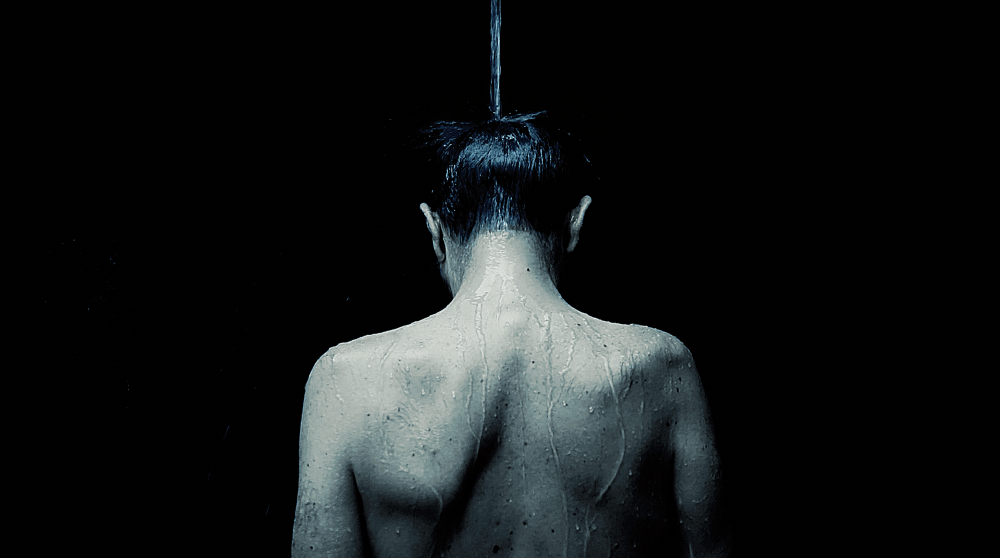
L’ecumenismo e la multiculturalità sono caratteri chiave nel tuo lavoro. Credi che questo riesca a riflettere la realtà che riscontri nella società?
Negli ultimi decenni la mia evoluzione è stata messa alla prova dalle idee piantate in me sin dalla mia infanzia. Lavorare con cosi tante persone con storie ed etnie radicalmente differenti dalle mie, e che si presentano ai miei servizi fotografici, mi ha informato, educato e introdotto in maniera molto personale a persone che forse non avrei mai incontrato in altri contesti, e questo è filtrato e presentato attraverso le immagini catturate e le emozioni che i miei modelli sono in grado di condividere davanti alla macchina fotografica. Forse, invece che la società, spero che la nostra esperienza comune, l’umanità, il potere di aggregazione e il senso di comunità si rifletta nel lavoro.
Su quali basi scegli i modelli nei tuoi shootings?
Generalmente, coloro che sono disposti a posare possono partecipare a condizione che siano in grado di gestire e sostenere le posizioni a volte complesse che sono richieste per un progetto specifico. Tutti i tipi di corporatura sono più che benvenuti. Per La terra delle ferite, il discorso è stato differente. Essendo un lavoro autobiografico, una sorta di diario emotivo che avrei poi diviso col gli altri, ho dovuto includere le persone chiave della mia vita. Mi sono ritrovato a contattare amici, parenti, ex amanti, persone del mio passato e li ho invitati a posare per questo progetto. Ho anche cercato modelli che potessero portare un ampia gamma delle proprie emozioni senza aver paura di essere esposti, facendo si che anche le loro storie facessero parte del retroscena di questo lavoro.
Questo film è un anello del tuo percorso creativo o senti che in qualche modo rappresenti un punto di svolta?
Assolutamente un grande punto di svolta. Credo che La terra delle ferite sia stato un nuovo punto di partenza. Per costruirla sono stato forzato ad espormi completamente, tutte le mie protezioni, la mia pelle, tutto via… Era l’unico modo per riscoprire un onestà interiore che cercavo da tempo. Ho iniziato un viaggio 4 anni fa, la decisione era quella di lasciare il vecchio me alle spalle ed aprire una nuova porta. Una porta su di una strada alternativa, diversa. Mi emoziona il pensare dove questa porta e questo lavoro mi porteranno, ma allo stesso tempo non vado di fretta a scoprirlo, non ne ho un esigenza immediata, il percorso e il processo al momento hanno tutta la mia attenzione.
Ti riconosci nella decisa atmosfera religiosa che qualcuno individua nella tua opera?
Il termine “religioso” è cosi carico di simbologia quindi rischioso, non me la sento di fare un connessione diretta, quindi ti risponderei NO. Ma se invece “Religioso” può essere un interpretazione del silenzio, della ricerca della centralità nella sua ieraticità, dell’accettazione e finalmente della consapevolezza del proprio essere, allora forse si… Questi ultimi, sono tutti gli elementi che cerco e che sostengono la mia ricerca ne La terra delle ferite.
—
“Between the body and the soul exists a matter/form relationship as if the soul were the real shape of the body”. Aristotle’s thought reflects what was the role of the human body in Classical Art. The sculptor focused on human features, trying to realistically recreate their forms by exalting them, in the case of heroes, sovereigns and athletes, selecting the most suitable expressive value of spatial dynamics, of gestures and glances. Just think, for example, of the Riace Bronzes, Myron’s Discobolus, the Laocoon.
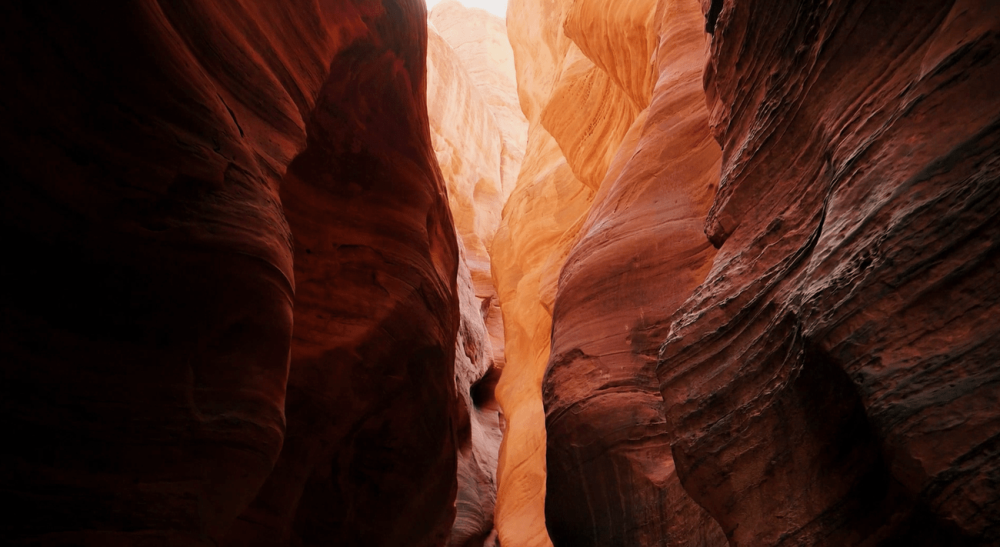
In the following centuries this approach was often replicated. Think about Michelangelo’s sculptures, or the paintings of Mattia Preti’s, as examples. The human body is back, front and center with its formal characteristics mainly with the Baroque, artworks such as Proserpines Rape, by Gian Lorenzo Bernini, which are paradigms – and then with Neoclassicism, The Three Graces, by Antonio Canova. However, certain social-cultural dynamics were gradually introducing new elements: such as the Council of Trento, which closely connected the human being’s representation to devotional purposes.
Body as a “medium”
As the centuries passed, even with due exceptions, the human body ended its existence in the Arts for its formal values, progressively becoming a functional tool to communicate messages, and to express social or environmental feelings. Besides Catholicism, Protestant-Puritanism also contributed to this: Is there a Flemish painting with a nude body? And so on until the 19th-century Realism, 20th-century New Objectivity, and also with Pop Art, where the body is turned into an object.
In Contemporary Art, the body reappears free from sociological waste products: Robert Mapplethorpe is a perfect example with his photographic statues sculpted by light. But there is an Italian artist who for decades has placed the forms of the naked human body at the center of his research. Not as the “subject” of his photographs, or his videos, but as a “medium” in the construction of fascinating and monumental textures. A “palette” of organic forms that – re-elaborated in the studio – they build other forms, and fantastic architectures: nests, flowers, feathers, schools of fish.
Monumental dimensions
We are talking about Angelo Musco, originally from Naples, Italy, now professionally established and a permanent resident in the USA, between New York and Pennsylvania, from where he has achieved International success, with his exhibitions, and his inclusion in absolutely prestigious events thanks to his rigorous modus operandi, with Global inclusivity. The selection of his subjects has a central role because they animate his involving, often sensual and sometimes almost disturbing compositions when they evoke Dante’s Circles, or Universal Judgements, probably admired by him during his years in Italy. “I was born as a painter in the Baroque Naples, the underground Naples, the Naples of suspended lives, and the Naples of Greek mythologies,” he points out.

A creative and surely complex procedure made of: calls for castings, choices of locations, photographic shooting, organized sessions all over the world, from New York to Berlin, London, Paris, Buenos Aires, soon to New Zealand and Australia, to his native Naples, with thousands of volunteers involved, followed by a long and precise work of post-production. Musco’s last undertaking is a new photographic project, which started 4 years ago. We are talking about “The Land of Scars”, with monumental dimensions, about 12 meters by 3.5.
Autobiography written by events and people
“A project in which the subjects that take part in the picture are all the people who have left a mark in my soul and have changed me and my daily life “says the artist. “An immense emotional diary,” is how he describes it, that he decided to tell with a film that goes over his complex evolution and therefore becomes a sort of autobiography written by events and people. “The Land Of Scars” – homonym title- has already had a premiere in New York, at the School of Visual Arts theater. While waiting for the public distribution, the final trailer has recently been released. We asked Angelo Musco to tell usalk all about it…
You are known for using the human body, but the film starts with fascinating landscape images. Does your panic feeling also look at the Earth?
The Earth, its smell, heat, and matter are at the center of this visual diary, so absolutely yes. A connection more visible than ever, this time it is not just visual, but physical, in direct contact with my body, which is present for the first time in the work in a radical way. An introspective search for inner roots, and in order to make it happen I had to begin a long search inside but also outside of myself, changing the places that surrounded me, thus beginning a series of long trips that accompanied me throughout the duration of these last 4 years – new landscapes but with a constant sense of familiarity, companions on the journey and therefore front and center in this movie.
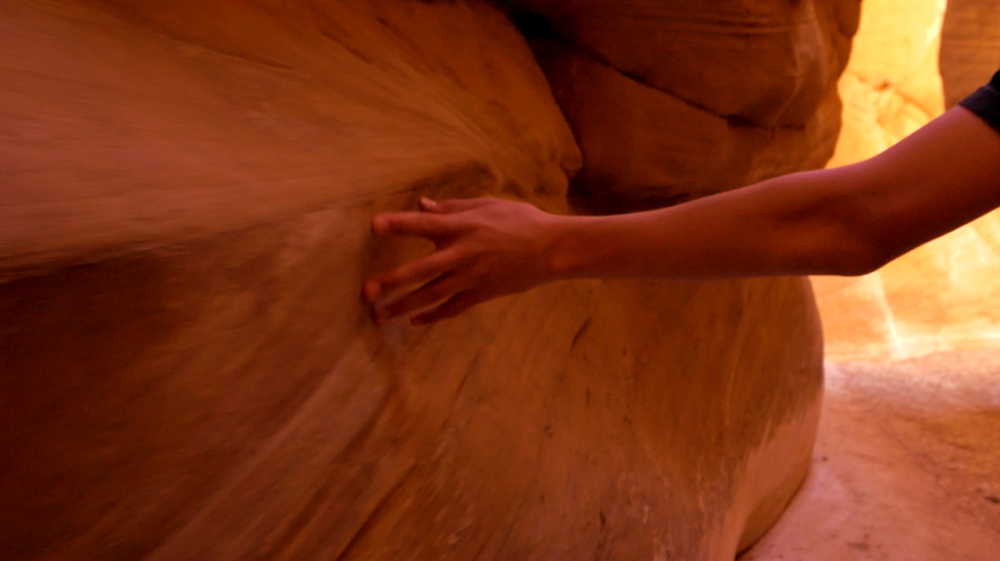
Can you identify a moment when you assigned such a strong expressive value to the naked human body that it becomes almost exclusive in your work?
The people selected in this documentary, bare their bodies not only physically, but they tell and bring their pain for the first time in a public project. Their face, eyes, hands, they tell their story, sharing their pain, bringing it out and giving me permission to share it with others and write a story not only visual but also told in person in the documentary, “The Land Of Scars,” where they tell their story in front of the camera. For the first time, I decided to pose together with them. This was the first time I participated as a model in my work. I had the need not only to remove my clothes but also the need for a new skin, carrying on my body, like tattoos, the marks and emotional scars of the people who have marked my life, giving voice to their emotional wounds. An inner diary, an autobiographical work in which I could not help but participate.
From watching the film, the great value you assign to the concept of “team” leaks out. Can you illustrate this for us?
At the simplest level, for the construction of images, I constantly need people, bodies to work with. As the photo shoots have grown, they have become more complex and meticulous, thus involving many more people not only as models but as assistant photographers and assistants on the floor, that is, those who are involved in the construction of the compositions. From there the growth has continued in a progressive way. I was able to build relationships with people who now know the work, the building process and the dynamics of each event, and project after project they became a constant part of the process, to the point where we created a community of models and a team that work perfectly together. We have built a community in which individual participants become something greater than themselves, thanks to the power of aggregation, the driving force and basic concept behind all the images I create.
Ecumenism and multiculturalism are key characters in your work. Do you think this succeeds in reflecting the reality you find in society?
Over the past decades my evolution has been challenged by the ideas planted in me since my childhood. Working with so many people with histories and ethnicities that are radically different from my own, and who show up for my photo shoots, has informed, educated, and introduced me in a very personal way to people I might not have encountered in other contexts, and this is filtered and presented through the images captured and the emotions my models are able to share in front of the camera. Perhaps instead of society, I hope that our shared experience, humanity, power of togetherness, and sense of community is reflected in the work.
On what basis do you choose models in your shoots?
Generally, those who are willing to pose, can participate as long as they can handle and sustain the sometimes-complex positions that are required for a specific project. All body types are more than welcome. For The Land of Scars, the story was different. Being an autobiographical work, a kind of emotional diary that I would later share with others, I had to include key people of my life. I found myself contacting friends, relatives, former lovers, people from my past and invited them to pose for this project. I also looked for models who could bring a wide range of their own emotions without being afraid to be exposed, making their stories part of the backstory of this work as well.
Is this film a link in your creative journey or do you feel that in some way it represents a turning point?
Absolutely a big turning point. I think The Land of Scars was a new starting point. To build it I was forced to expose myself completely, all my protections, my skin, everything came off… It was the only way to rediscover an inner honesty that I had been looking for, for a while. I began a journey 4 years ago, the decision was to leave the old me behind and open a new door, a door to an alternative, different path. It excites me to think where this door and this work will take me, but at the same time I am not in a hurry to find out. I don’t have an immediate need, the path and the process at the moment have my full attention.
Do you recognize yourself in the definite religious atmosphere that some people identify in your work?
The term “religious” is so laden with symbolism therefore risky. I don’t feel like making a direct connection, so I would answer NO. But if instead “Religious” can be an interpretation of silence, of the search for centrality in its solemness, of acceptance and finally awareness of one’s own being, then perhaps yes… The latter are all the elements I seek and that support my research in The Land of Scars.
(traduzione di Paola Salzano)
THE LAND OF SCARS / A Documentary Film by Angelo Musco – Trailer 2 – 2023 from Musco Studio on Vimeo.



